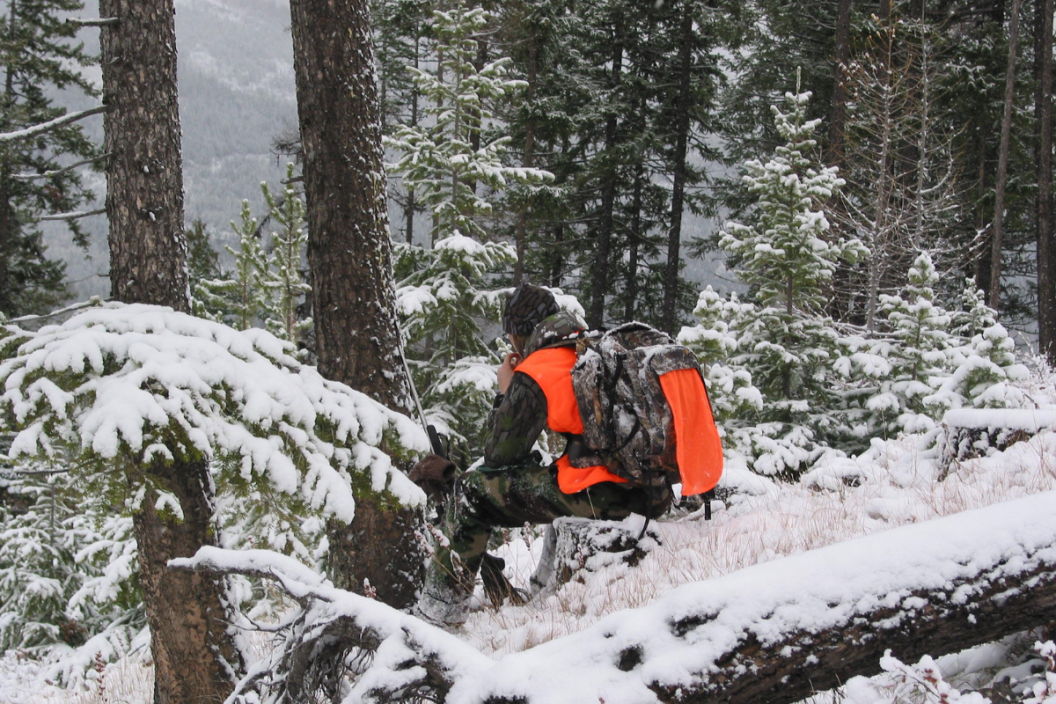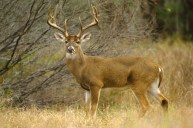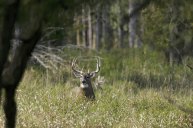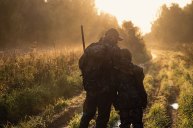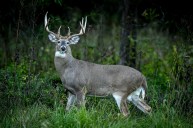Shooting an animal can be rather intense. Emotions are at an all time high as you center in on its vitals. Certain shots can be less forgiving than others. Even if you do make a good shot, with all of that adrenaline pumping, it can be hard to analyze how the deer reacts to the hit. When I was growing up, we were always taught about certain reactions that a deer will make when the hit is fatal. Over the years I have come to learn that this isn't so black and white, and even if it were, it's hard to calm down enough to notice after pulling the trigger, especially as a new hunter. Because of this, I had to rely heavily on what the blood trails would tell me.
In an ideal scenario, you would make a clean shot, the deer would jump up, kicking its back legs in the air indicating a heart shot, and would take its last breath about 40 to 60 yards away. But hunting isn't always perfect, and even the best marksman makes less than perfect shots. Sometimes this is the fault of the hunter, and sometimes unforeseen conditions come into play. Regardless, having a good foundation of what to look for in a blood trail will overall make you a better hunter, and ideally help you find that trophy buck quicker and more effectively. Here are some colors to look for at the beginning of the blood trail, and how they will determine the rest of your tracking.
Bright Red
Over the years I have heard hunters disagree about what bright red blood can mean. While small drops of bright red blood could indicate a muscle wound, this usually isn't the case. In my years of hunting and countless hours spent tracking deer, an abundance of bright red blood only means one thing, and that is an artery shot! Generally speaking, the brightness of the blood would indicate that the blood is extremely oxygen-rich, therefore likely coming out of a main artery. In this case, pay close attention to how much blood there is within the first 50 yards. If it is in fact a main artery hit, there will be buckets of blood, and likely your deer won't be very far.
The time you take to track this deer will depend on how much blood there is. If it's pumping out excessively on both sides, waiting an hour should be more than enough. If it's sporadic, longer (maybe even overnight) is going to be the safest option. Invite some friends to help spot blood, and do a grid search if necessary.
Dark Red
If you spot early blood that is a very rich dark red to the point that it's almost maroon, chances are you made a liver shot. This is an extremely fatal shot and will inevitably kill the deer after some time. However, depending on how much of the liver was hit, whether or not it was a complete pass through, and how big the wound is, your deer might not die as quickly or as humanely as you'd hope for. I have made several liver shots on deer throughout the years, and I am always amazed by the inconsistency of the recovery. I have had giant bucks expire within 100 yards of the shot, and I have had does run a half mile or more. Again, this will ultimately depend on several factors, and you should always err on the side of caution.
If you didn't hear your deer crash, wait at least an hour before you start looking for blood. Follow the trail for about 50-75 yards to analyze how much blood is being lost and then make your decision on how to proceed. A good rule of thumb I live by is that if I don't find the deer within 100 yards after a liver shot, I wait 5-7 hours before I go any further. This rule has suited me well over the years, and I think you'll find success with it.
Pink/Bright Red with Bubbles
Ahh yes, the type of blood we always hope for and are so relieved when we do see it. Blood that has a tint of pink in it, with unmistakable air bubbles in it, generally indicates a lung or heart shot. This is the ideal scenario, and one that all hunters should strive for. A deer hit in this area will not live long, and will undergo little to no suffering. This blood trail will be extremely easy to follow, and the blood should remain consistent all of the way through to the body, which will likely be within 150 yards. On a heart or lung shot, I typically wait 1-2 hours before tracking.
Green/Yellow
Ugh, the dreaded gut shot is indicated by greenish or yellowish blood. If you have hunted long enough, it's something that you will most likely experience. The feeling of disappointment and anxiety that comes with it is almost like its own gut shot. It's likely that before you even find the arrow, you'll smell the putrid aroma of stomach and digestive matter. I'm not going to sugar coat it—this is going to be a very challenging track. One that, although not required, appreciates the help of several friends for the inevitability of a grid search. Depending on the hit, a gut shot will likely end up being fatal, but it's going to take some time, and any pressure put on that deer will send it running for the hills and possibly out of your life forever.
In the unfortunate instance of a gut shot, I am always overly cautious and opt to wait until the next day before I start looking. If it appears that rain is in the forecast, you could always get on it sooner, but there's a solid chance you end up bumping the deer and doing more harm than good. If you have access to tracking dogs, this is an excellent time to utilize them. There are several websites out there with contact information to local deer trackers that will help you for a fee. If this isn't an option, bribe your friends and put on some comfortable boots!
Final Thoughts
There is a common saying in the hunting world, and it's one that I can't emphasize enough: "When in doubt, back out." While we as conservationists and good sportsmen always want to honor the animal by eating the meat and preserving as much as we can, that won't do you any good if you keep bumping the animal.
It's important to always strive to make ethical and fatal shots. Unfortunately, everything doesn't always work out the way we plan. Whether this is due to our own error or uncontrollable conditions that affect our shots, we need to be prepared. Initial signs of blood can help us make the right decision on how to proceed with our tracking and ensure we recover our animal as quickly and effectively as possible.
